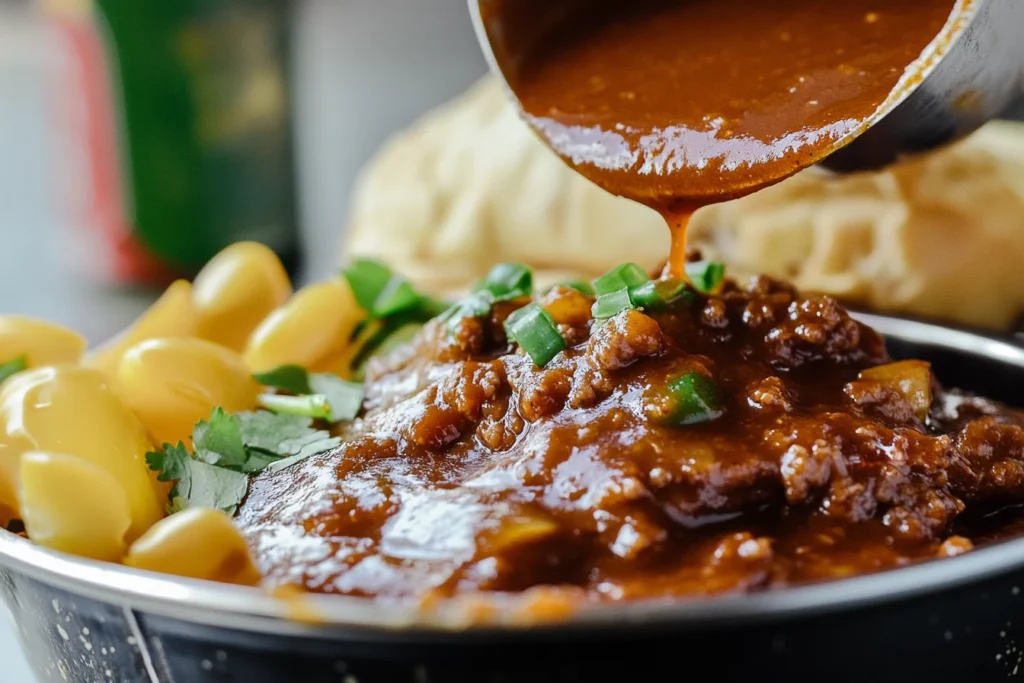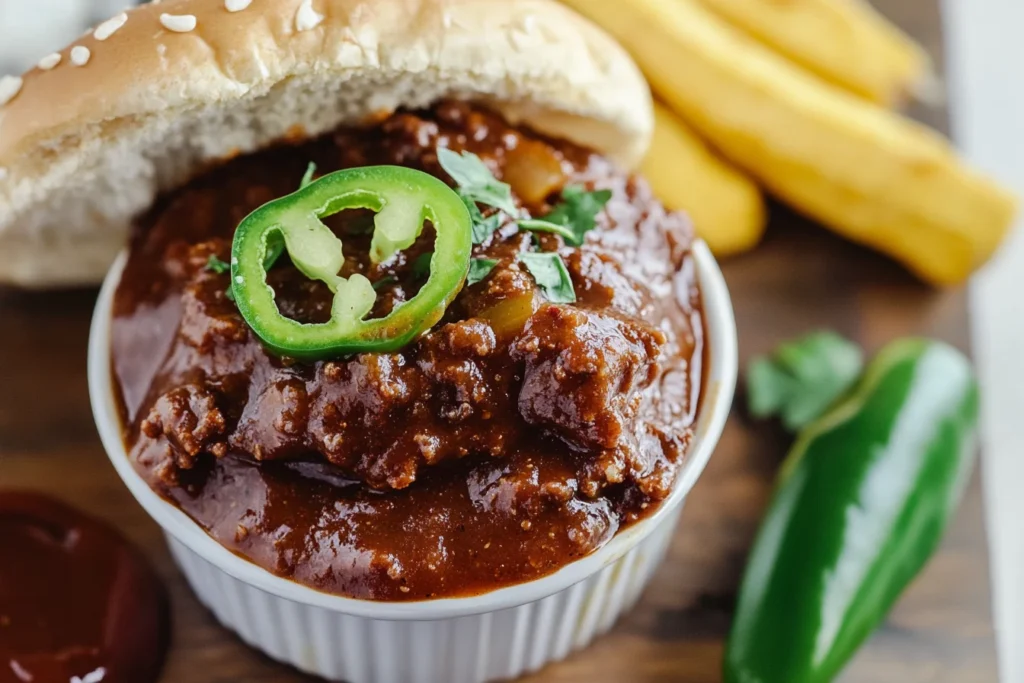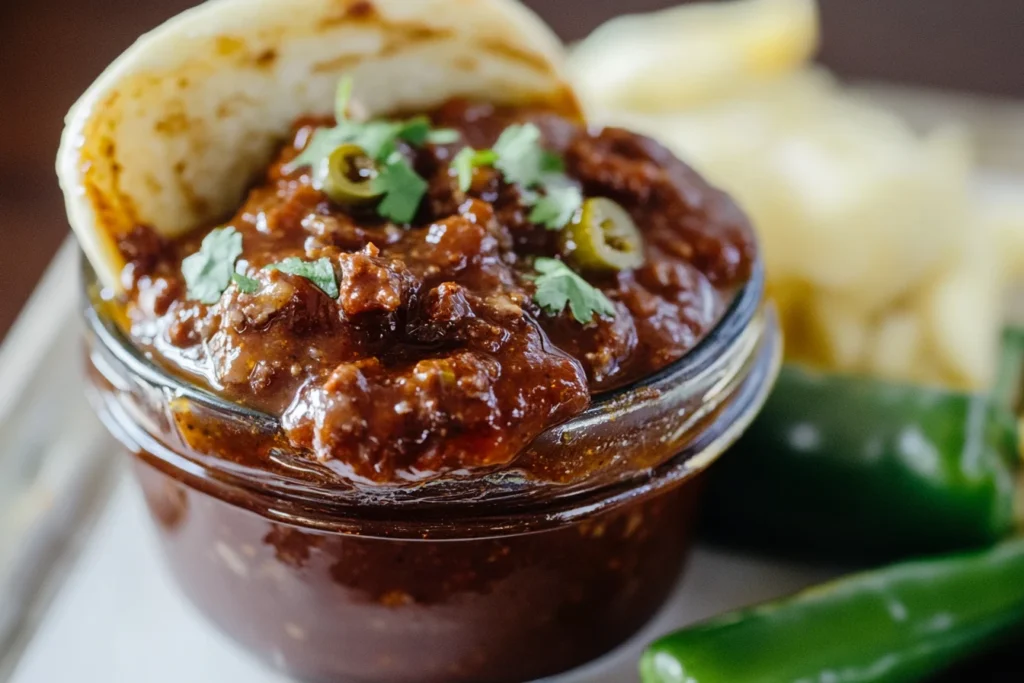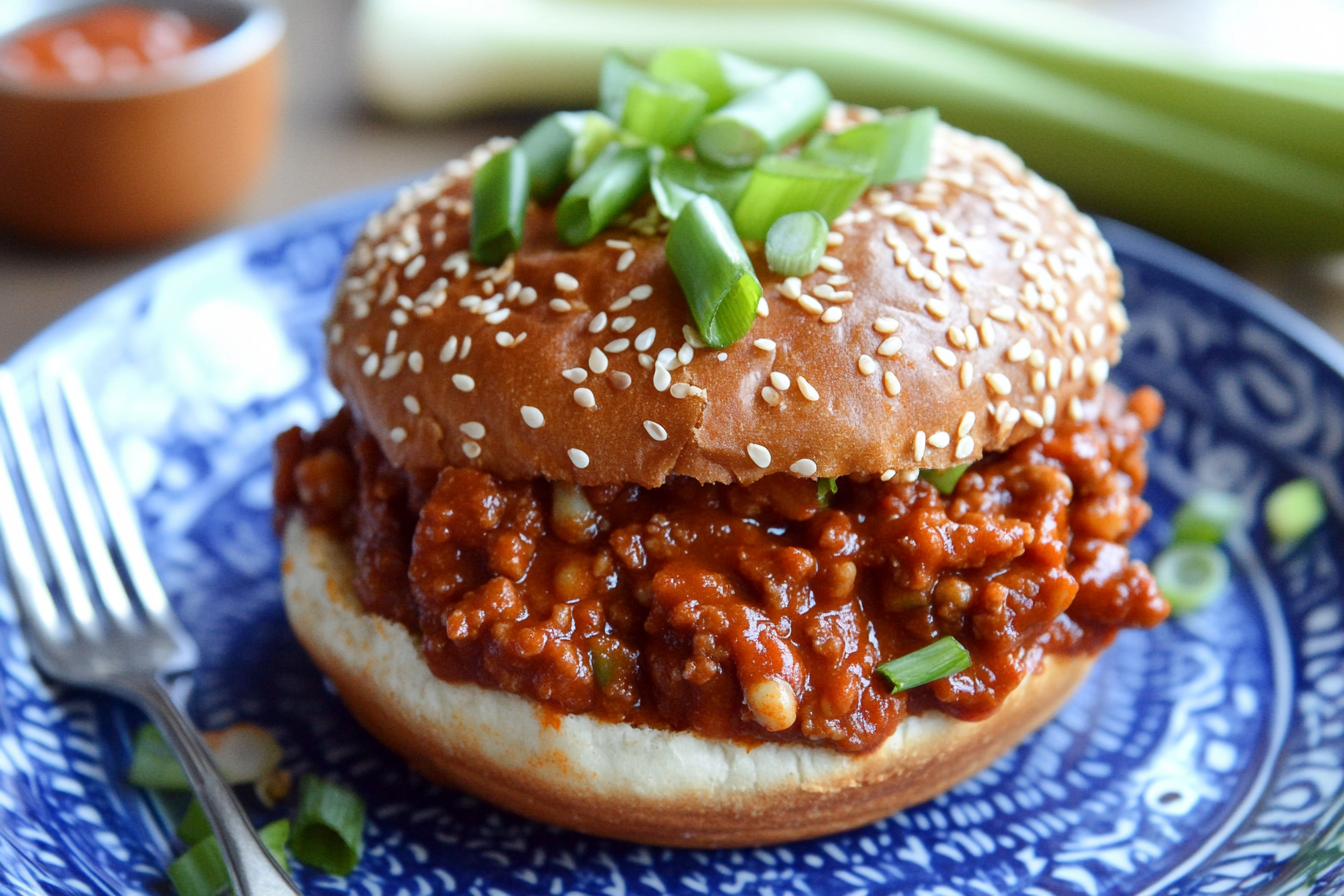Part 1: Understanding Not So Sloppy Joe Sauce
H1: Introduction to Not So Sloppy Joe Sauce
Not So Sloppy Joe sauce is a delightful twist on the classic sloppy joe recipe. It takes the core elements of the traditional sauce—sweetness, tanginess, and a touch of savory—and refines them for a thicker, less messy experience. Unlike traditional sloppy joe sauces, this variation focuses on a more cohesive texture, making it perfect for a variety of dishes beyond just sandwiches.
Differences from Traditional Sloppy Joe Sauce

- Consistency: Traditional sloppy joe sauce is loose and saucy, while Not So Sloppy Joe sauce is thicker and binds better.
- Versatility: While the traditional sauce is mostly used in sandwiches, the not-so-sloppy version works great as a topping for burgers, baked potatoes, or even as a pizza base.
- Health Considerations: Often, this modern adaptation uses fewer processed ingredients and caters to specific dietary needs, such as being low-sugar or gluten-free.
H2: Origins and Popularity
History of the Sloppy Joe Recipe
The origins of sloppy joe sauce date back to the early 20th century, with some tracing its roots to a bar in Sioux City, Iowa. The original dish was a simple combination of ground beef, onions, and ketchup served on a bun. Over time, the sauce became a staple in American homes, popular for its affordability and ease of preparation.
The Evolution into “Not So Sloppy Joe”
As families sought cleaner, less-messy options for quick meals, the recipe evolved into a thicker, more adaptable version. By adjusting the ingredient ratios and focusing on texture, Not So Sloppy Joe sauce gained traction for its practicality and flavor.
H3: Key Features of Not So Sloppy Joe Sauce
- Thicker Consistency: Achieved by balancing tomato paste and liquid ingredients, it clings better to food.
- Layered Flavor: A mix of sweet, tangy, and savory notes ensures a versatile profile.
- Health-Conscious Options: Adaptable for low-sugar, low-sodium, or allergen-free variations.
Health-Conscious Adaptations
Modern recipes often include healthier sweeteners like honey or maple syrup and eliminate high-fructose corn syrup. Gluten-free Worcestershire sauce or soy sauce substitutes cater to those with dietary restrictions.
H4: Benefits of Homemade Sauces
Making Not So Sloppy Joe sauce at home offers several benefits:
- Control Over Ingredients: Choose organic, preservative-free components to ensure a clean recipe.
- Customization for Dietary Needs: Adjust sweetness, salt levels, and spice to suit individual preferences.
- Enhanced Flavor: Fresh ingredients deliver a more vibrant taste compared to store-bought alternatives.
H5: Essential Flavor Profile
A successful Not So Sloppy Joe sauce balances the following:
- Sweetness: Typically from brown sugar, honey, or even molasses.
- Tanginess: Vinegar and tomato-based ingredients provide acidity.
- Savory Notes: Garlic, onion, and Worcestershire sauce add depth.
Importance of Texture
Texture is as important as taste. A well-prepared sauce clings to meats and bread without dripping excessively, making it suitable for diverse applications.
H6: Common Uses of Not So Sloppy Joe Sauce
While sandwiches are the go-to choice, Not So Sloppy Joe sauce can also shine in:
- Burgers: Spread on buns or layered with toppings.
- Casseroles: Use as a base for layered dishes.
- Dips: Pair with tortilla chips or breadsticks.
- Baked Potatoes: Pour over a baked potato with shredded cheese for a hearty meal.
Pairing ideas:
- Serve with coleslaw for a tangy contrast.
- Add potato wedges or sweet potato fries for a satisfying side.
H2: Overview of Ingredients
The magic of Not So Sloppy Joe sauce lies in its carefully selected ingredients. Each plays a critical role in achieving the sauce’s signature flavor and texture.
Main Components
- Tomato Paste/Ketchup: The base for sweetness and tang.
- Sweeteners: Usually brown sugar, but honey or maple syrup are excellent substitutes.
- Vinegar: Adds acidity to balance the sweetness.
- Worcestershire Sauce: A splash of umami depth.
- Spices: Garlic, onion, and paprika for a smoky, savory kick.
Importance of Each Ingredient
For instance:
- Tomato paste ensures the sauce has a robust, concentrated flavor.
- Vinegar lifts the profile, preventing it from becoming overly sweet or flat.
H3: Nutritional Value of Ingredients
Understanding the nutrition in your sauce is vital:
- Calories: A serving often contains about 50–70 calories, depending on sweetener and fat content.
- Macros Breakdown:
- Carbohydrates: From sugars like brown sugar or ketchup.
- Fats: Minimal, unless oil or butter is added.
- Proteins: Derived from the Worcestershire sauce or broth.
- Allergen Considerations: Worcestershire sauce may contain gluten, and some ketchups include corn syrup.
H4: Storing and Shelf Life
To maintain the freshness of homemade Not So Sloppy Joe sauce:
- Refrigeration: Store in an airtight container for up to a week.
- Freezing: Freeze in small portions for up to three months.
- Reheating Tips: Thaw overnight in the fridge, then reheat on low heat, adding a splash of water or broth to restore consistency.
H5: Versatile Substitutions
If certain ingredients are unavailable or need replacement:
- Sweeteners: Replace brown sugar with honey, maple syrup, or agave nectar.
- Vinegar Alternatives: Lemon juice or white wine vinegar works well.
- Vegan Substitutions: Use soy sauce or tamari instead of Worcestershire sauce.
Vegan and Gluten-Free Options
Opt for coconut aminos and gluten-free ketchup to make a sauce suitable for all diets.
Ingredients in Not So Sloppy Joe Sauce

Part 2: Detailed Ingredient Breakdown
H1: Sweeteners in Not So Sloppy Joe Sauce
Sweeteners play a vital role in balancing the tangy and savory elements of the sauce. The choice of sweetener can dramatically alter the flavor profile and nutritional value.
Role of Brown Sugar or Honey
- Brown Sugar: Adds a deep, molasses-like flavor that complements the tangy tomatoes.
- Honey: A natural alternative for those seeking a lighter, floral sweetness.
Substitutes for Reducing Sugar Content
For a lower-sugar option, consider:
- Stevia or monk fruit sweeteners: These provide sweetness without extra calories.
- Applesauce: Natural fruit sugars with added moisture.
- Date paste: A fiber-rich, nutrient-dense substitute.
H2: Tangy Components
Tanginess is essential for cutting through the richness of the sauce, making it more vibrant and balanced.
Types of Vinegar
- Apple Cider Vinegar: Offers a mellow, slightly fruity acidity.
- White Vinegar: A sharper tang, perfect for bold flavors.
- Balsamic Vinegar: For a sweeter, richer depth of flavor.
Lemon Juice as an Alternative
Fresh lemon juice can replace vinegar in a pinch, adding brightness without overpowering the other ingredients.
H3: Tomato-Based Elements
Tomatoes form the backbone of Not So Sloppy Joe sauce. They provide natural umami and tang while serving as the primary base.
Tomato Paste vs. Ketchup
- Tomato Paste: A concentrated option that gives thickness and a robust flavor.
- Ketchup: Adds sweetness and tang but may require balancing with additional spices.
Importance of Fresh Tomatoes
For a fresher taste, consider using:
- Blended Fresh Tomatoes: Slightly cooked down to release their natural sweetness.
- Fire-Roasted Tomatoes: For a smoky twist.
H4: Savory Ingredients
The savory elements in Not So Sloppy Joe sauce create depth and complexity.
Worcestershire Sauce and Soy Sauce
- Worcestershire Sauce: A classic ingredient that brings a unique combination of sweet, savory, and tangy flavors.
- Soy Sauce: Adds a salty umami note, especially useful in vegan adaptations.
How Garlic and Onion Enhance Flavor
- Garlic: Provides a pungent, aromatic base.
- Onion: Adds sweetness and texture as it cooks down.
H5: Spices and Herbs
A well-spiced sauce elevates the overall experience. Typical spices include:
- Paprika: Smoky or sweet, depending on preference.
- Chili Powder: For mild heat and earthiness.
- Cumin: Adds warmth and depth.
- Optional Herbs: Oregano or thyme for a Mediterranean twist.
Creating Depth with Layers of Spice
Toast spices before adding liquids to unlock their full flavor potential.
H6: Liquid Additives
The liquid elements ensure the sauce achieves the desired consistency.
Use of Broth or Water
- Broth: Adds flavor and richness. Beef broth is traditional, but vegetable broth works well for vegetarian options.
- Water: A neutral thinning agent.
Adjusting the Sauce Thickness
- For a thicker sauce, simmer uncovered or add a cornstarch slurry.
- For a thinner sauce, add more liquid gradually until the desired consistency is reached.
H2: Optional Add-Ins for Flavor Variations
Customizing the sauce with optional ingredients can make it uniquely yours.
Hot Sauce for Heat
A few dashes of your favorite hot sauce can introduce a spicy kick.
Mustard for Tanginess
Yellow or Dijon mustard provides an additional layer of tanginess.
Other Ideas
- Liquid Smoke: For a BBQ-like flavor.
- Molasses: For a deeper, richer sweetness.
H3: Allergen-Free Modifications
Creating a sauce free from common allergens is simpler than it seems.
Gluten-Free Worcestershire Sauce
Traditional Worcestershire sauce contains gluten, but gluten-free versions are widely available.
Dairy-Free and Nut-Free Adaptations
- Opt for plain, non-dairy ketchup or tomato paste.
- Avoid cross-contaminated spices by sourcing from reputable suppliers.
H4: Homemade vs. Store-Bought Ingredients
Pros and Cons of Store-Bought Ketchup
- Pros: Convenient, consistent in flavor.
- Cons: Often includes high-fructose corn syrup and preservatives.
Benefits of Making Ingredients from Scratch
- Customization: Control the sugar and spice levels.
- Freshness: Homemade tomato paste or ketchup tastes noticeably fresher.
H5: Ingredient Sourcing Tips
To enhance the quality of your sauce, consider:
- High-Quality Spices: Opt for freshly ground or whole spices for maximum flavor.
- Organic Produce: Tomatoes, onions, and garlic from organic sources are more flavorful and nutrient-dense.
- Local Options: Farmers’ markets are a great place to find fresh, seasonal ingredients.
More FAQs
1. Can I make the sauce ahead of time?
Yes! It can be made a day in advance. The flavors meld beautifully when left to sit overnight.
2. Is this sauce freezer-friendly?
Absolutely. Freeze portions in airtight containers for up to three months.
3. What’s the best way to reheat the sauce?
Use a stovetop on low heat, adding a splash of water or broth if it has thickened too much.
4. Can I make this sauce vegan?
Yes, by using soy sauce or tamari instead of Worcestershire sauce.
5. What’s a good substitute for brown sugar?
Honey, maple syrup, or coconut sugar work well.
6. Can I use canned tomatoes instead of fresh?
Yes, canned tomatoes (especially fire-roasted) are an excellent substitute.
7. How can I reduce the tanginess?
Add more sweetener or a pinch of baking soda to neutralize the acidity.
8. Is this sauce suitable for kids?
Yes, but you may want to reduce spices or omit hot sauce for younger palates.
9. What are good pairing suggestions?
Serve with coleslaw, potato salad, or even as a dip for fries.
10. Can I make this sauce without sugar?
Yes. Use sugar substitutes like stevia, monk fruit, or natural fruit purees for sweetness.
Ingredients in Not So Sloppy Joe Sauce

Part 3: Preparing and Customizing the Sauce
H1: Step-by-Step Preparation Guide
Crafting Not So Sloppy Joe sauce at home is straightforward. Follow these steps to achieve a perfect balance of flavor and texture:
1. Assemble the Ingredients
Gather:
- Tomato paste or ketchup (depending on preference).
- Brown sugar or your chosen sweetener.
- Vinegar (apple cider, white, or balsamic).
- Worcestershire or soy sauce.
- Garlic, onion, and spices like paprika, chili powder, and cumin.
- Broth or water to adjust consistency.
2. Prepare the Base
- Sauté diced onions and minced garlic in a bit of oil over medium heat until fragrant.
- Add spices (paprika, cumin, chili powder) to toast briefly for enhanced flavor.
3. Incorporate Liquids and Sweeteners
- Stir in tomato paste/ketchup, sweetener, and vinegar.
- Add Worcestershire or soy sauce for umami depth.
4. Simmer for Flavor
- Slowly pour in broth or water, stirring to achieve desired thickness.
- Allow the sauce to simmer for 10–15 minutes, letting the flavors meld.
5. Taste and Adjust
- Balance the sweetness, tanginess, and salt levels to your liking.
- Adjust consistency by adding more broth or simmering longer to thicken.
H2: Customizing Sweetness Levels
Sweetness can make or break Not So Sloppy Joe sauce. Adjust it to suit your preferences:
Balancing Sweeteners
- Start with less sweetener and gradually increase, tasting as you go.
- Combine multiple sweeteners (e.g., brown sugar and honey) for a nuanced sweetness.
Reducing Sugar for a Healthier Version
- Opt for natural alternatives like stevia or monk fruit.
- Use unsweetened applesauce for a subtle sweetness with added moisture.
H3: Adjusting Consistency
The ideal Not So Sloppy Joe sauce is thick enough to cling to food but not overly sticky. Achieve this by tweaking its consistency:
Tips to Thicken the Sauce
- Simmer uncovered to reduce excess liquid.
- Add a small amount of cornstarch or flour slurry if needed.
Tips to Thin the Sauce
- Gradually mix in broth or water until desired thickness is achieved.
- Be cautious not to dilute the flavor; adjust seasonings accordingly.
H4: Enhancing the Flavor Profile
For a richer, more layered sauce, consider these techniques:
Layering Flavors
- Toast spices early in the cooking process for maximum aroma.
- Add a dash of balsamic vinegar or molasses for depth.
Using Marinades or Slow Cooking
- Use the sauce as a marinade for ground beef or chicken before cooking.
- Slow-cook the sauce with the meat for a deeply integrated flavor.
H5: Creative Variations
Put your own twist on the classic Not So Sloppy Joe sauce with regional or international influences.
Regional Twists
- Southern Style: Add a splash of BBQ sauce for smoky sweetness.
- Tex-Mex: Incorporate jalapeños, cumin, and cilantro.
International Spice Blends
- Indian-Inspired: Add curry powder and a touch of coconut milk.
- Mediterranean: Use oregano, thyme, and a hint of lemon zest.
H6: Pairing Suggestions
A good sauce is only as good as the dishes it accompanies. Here are pairing ideas to maximize its potential:
Best Bread and Buns
- Brioche Buns: Soft and slightly sweet, perfect for sandwiches.
- Whole-Grain Rolls: A hearty option for a healthier meal.
- Potato Rolls: Enhance the sauce’s richness.
Complementary Drinks and Sides
- Serve with a crisp coleslaw or tangy pickles for balance.
- Pair with lemonade or iced tea for a refreshing contrast.
H2: Troubleshooting Common Issues
No recipe is foolproof, and sometimes adjustments are necessary. Here’s how to fix common problems:
Fixing Overly Sweet Sauce
- Add a splash of vinegar or lemon juice to cut the sweetness.
- Incorporate a pinch of salt or chili powder to balance the flavor.
Correcting Overly Tangy Sauce
- Stir in more sweetener, a small pinch of baking soda, or a splash of cream to neutralize acidity.
Solving Texture Problems
- Too Thick: Thin with broth, water, or even a bit of tomato juice.
- Too Thin: Simmer longer or mix in a starch slurry to thicken.
H3: Storing the Sauce
Proper storage ensures your Not So Sloppy Joe sauce remains fresh and delicious.
Tips for Refrigerating Leftovers
- Store in an airtight container in the fridge for up to one week.
- Reheat on the stovetop or microwave, stirring to avoid separation.
Long-Term Freezing Methods
- Freeze in small, portioned containers or ice cube trays.
- Label with the date for easy tracking; use within three months.
H4: Presentation and Serving Tips
Make your dish visually appealing to elevate the dining experience.
Making It Look Appealing
- Drizzle the sauce artfully over sandwiches or burgers.
- Sprinkle freshly chopped parsley or grated cheese for a professional touch.
Garnishes and Plating Ideas
- Top with sliced jalapeños or a dollop of sour cream for contrast.
- Serve alongside vibrant sides like roasted vegetables or colorful salads.
H5: FAQs About Not So Sloppy Joe Sauce
1. Can I make the sauce spicier?
Yes! Add hot sauce, chili flakes, or fresh jalapeños for extra heat.
2. What if I don’t have tomato paste?
Use ketchup, canned tomatoes, or a mix of both.
3. How long should I simmer the sauce?
Simmer for 10–15 minutes to blend flavors thoroughly.
4. Can I make a double batch for meal prep?
Absolutely. Scale up the ingredients proportionally and freeze portions for convenience.
5. Is it okay to skip the sweetener?
Yes, but the sauce may lack balance. Consider using unsweetened applesauce as a replacement.
6. How can I make it creamier?
Stir in a small amount of heavy cream or dairy-free alternatives like coconut milk.
7. What’s the best way to serve it for kids?
Serve on soft buns with minimal spice and plenty of grated cheese for a kid-friendly meal.
8. Can I use this sauce as a pizza base?
Definitely! Its thick consistency and bold flavor work well for unconventional pizzas.
9. How do I avoid burning the sauce?
Cook on low to medium heat and stir regularly to prevent sticking.
10. Are there premade mixes for this sauce?
Yes, but homemade is fresher and allows for full control over the ingredients.

